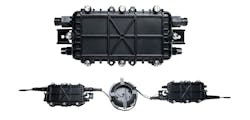The LOC-DROP® Fiber Drop Repair Solution was developed based on the ISP’s need to reduce the cost to repair a subscriber outage caused by a severed fiber drop cable.
Although fiber-to-the-home (FTTH) networks are extremely robust, their weakest link can be a subscriber’s shovel. Early in the days of FTTH networks, it was standard practice for the ISP to replace a fiber drop that was damaged by gardeners, pet fence installers, landscapers, in-ground sprinkler installations, etc. This practice was deemed necessary because fiber was considered fragile, required skilled technicians to splice, and fiber attenuation was saved (margin) for potential other restoration activities and macro-bend losses bound to happen in the plant.
Today, FTTH networks have become widely deployed. We now have a great understanding of fiber’s capabilities, robustness, and the proper techniques for its handling by the labor force. What once required a $30,000 fusion splicer and an environmentally conditioned splicing vehicle, is now accomplished with <$5,000 fusion splicer and a small table or technician’s knee. Field installable connectors are also proving very reliable. And with the improvements in glass and splicing technology, the repair results are superior, even with less trained technicians.
With the explosion in FTTH subscriptions, the challenge the service provider faces each day is reducing the restoration cost to repair a damaged fiber drop cable. Due to fiber’s low-loss characteristics, some service providers have increased the length of the typical subscriber drop cable from 50-300 ft to 1,000-2,000 ft. This long cable length, along with obstacles such as driveways, roadways, sidewalks, patios, etc, adds up to significant restoration cost if replacing the entire drop was the only solution.
The LOC-DROP contains several design innovations to support the wide range of drop repair field conditions, including:
Compact Size: Not only reduces the cost but also, in buried installations, reduces the size of the required excavation. Enables the service technician to not only repair the service but restore the damaged site with simple tools (hand shovel, rake, etc.), versus calling out a separate restoration crew to replace and re-bury the fiber drop.
Simple: Assembly of the product is quick and easy and each unit ships with the necessary cable entry port sealing components to complete the repair. One product supports aerial, direct buried (without a handhole), poles or wall installations.
Robust: Designed for the rigors of OSP deployments, with conditions that include extreme hot and cold, wet or even submerged conditions, and pressures from direct buried installation. Engineered features designed specifically to meet the requirements of Telcordia GR-771-CORE specifications to help withstand these harsh conditions and maintain long-term connectivity.
Cost Effective: A very important attribute as the entire cost of a drop repair is borne on a single subscriber being serviced.
In addition to the single fiber repair housing, the LOC-DROP Fiber Repair Kit is a pre-configured tandem repair assembly designed for locations where fiber cable slack isn’t readily available. The repair kit consists of two housings factory interconnected and SC/APC terminated to an innovative micro-armored fiber cable assembly. This tandem kit reduces the technician’s on-site prep-time and associated labor costs while improving time-to-repair for increased subscriber satisfaction. A unique, patented feature of the tandem repair kit is that it was engineered to enable the installed tandem assembly to be identifiable on a fiber drop by a programmed OTDR. CLICK HERE to learn more.
Source: www.enginuitycom.com
Great idea and execution. An innovative product that will reduce repair time for fiber cuts. The product can be used in a direct buried or aerial application.
- 2024 ISE Network Innovators' Awards Judge

